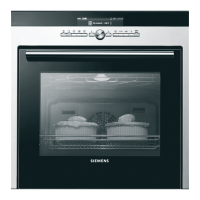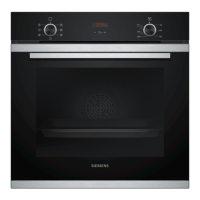12
Childproof lock
The oven has a childproof lock to prevent children switching it
on accidentally.
The oven will not react to any settings. The timer and clock can
also be set when the childproof lock has been activated.
If the type of heating and temperature or grill setting have been
set, the childproof lock interrupts the heating.
Activating the childproof lock
No cooking time or end time should have been set.
Press and hold the h button for approx. four seconds.
The
@ symbol appears in the display. The childproof lock is
activated.
Deactivating the childproof lock
Press and hold the
h button for approx. four seconds.
The
@ symbol goes out in the display. The childproof lock is
deactivated.
Changing the basic settings
Your oven has various basic settings. These settings can be
customised to suit your requirements.
No other time-setting option should have been set.
1.Press and hold the 0 button for approx. 4 seconds.
The current basic setting for the clock display is shown in the
display, e.g. c1 1 for selection 1.
2.Use the @ or A button to change the basic setting.
3.Confirm by pressing the 0 button.
The next basic setting appears in the display. You can scroll
through all levels with the
0 button and change the setting
with the
@ or A button.
4.To finish, press and hold the 0 button for approx. 4 seconds.
All basic settings are applied.
You may change the basic settings at any time.
Care and cleaning
With good care and cleaning, your oven will remain clean and
fully-functioning for a long time to come. Here we will explain
how to maintain and clean your oven correctly.
Notes
■ Slight differences in the colours on the front of the oven are
caused by the use of different materials, such as glass,
plastic and metal.
■ Shadows on the door panel which look like streaks, are
caused by reflections made by the oven light.
■ Enamel is baked on at very high temperatures. This can
cause some slight colour variations. This is normal and does
not affect their function. The edges of thin trays cannot be
completely enamelled. As a result, these edges can be
rough. This will not impair the anti-corrosion protection.
Cleaning agents
To ensure that the different surfaces are not damaged by using
the wrong cleaning agent, observe the information in the table.
Do not use
■ sharp or abrasive cleaning agents,
■ cleaning agents with a high concentration of alcohol,
■ hard scouring pads or sponges,
■ high-pressure cleaners or steam cleaners.
Wash new sponge cloths thoroughly before use.
Basic setting Selection 1 Selection 2 Selection 3
c1 Clock display always* only with
the
0 but-
ton
-
c2 Signal duration
upon completion of
a cooking time or
timer period
approx.
10 seconds
approx.
2 minutes*
approx.
5minutes
c3 Waiting time until a
setting is applied
approx.
2seconds
approx.
5seconds*
approx.
10 seconds
* Factory setting
Area Cleaning agents
Oven front Hot soapy water:
Clean with a dish cloth and dry with a soft
cloth. Do not use glass cleaners or glass
scrapers.
Stainless steel Hot soapy water:
Clean with a dish cloth and dry with a soft
cloth. Remove flecks of limescale,
grease, starch and albumin (e.g. egg
white) immediately. Corrosion can form
under such residues.
Special stainless steel cleaning products
suitable for warm surfaces are available
from our after-sales service or from spe-
cialist retailers. Apply a thin layer of the
cleaning product with a soft cloth.
Door panels Glass cleaner:
Clean with a soft cloth. Do not use a
glass scraper.
Glass cover for the
oven light
Hot soapy water:
Clean with a dish cloth.
Seal
Do not remove.
Hot soapy water:
Clean with a dish cloth. Do not scour.
Shelves Hot soapy water:
Soak and clean with a dish cloth or brush.
Telescopic shelves Hot soapy water:
Clean with a dish cloth or a brush. Do not
soak or clean in the dishwasher.
Accessories Hot soapy water:
Soak and clean with a dish cloth or brush.

